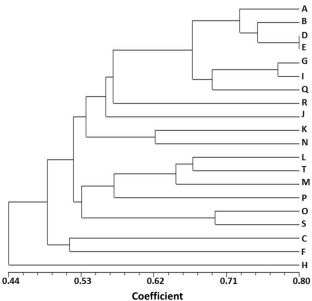Detection of diverse population of vegetative propagated Kinnow planting in western India
Short Communications | Published: 12 March, 2019
First Page: 124
Last Page: 129
Views: 3743
Keywords: Citrus, Genetic diversity, Kinnow, RAPD
Abstract
Genetic diversity in 20 accessions of kinnow collected (five each) from four orchards viz., Central Institute of Arid Horticulture (CIAH), Bikaner, Agricultural Research Station, (ARS) Bikaner, ARS, Sriganaganagar and Regional Research Station (RRS), Abhohar were evaluated through RAPD analysis. Each of the 11 primers tested generated amplicons and out of a total of 69 amplicons produced 66 were polymorphic, with an average polymorphism of 95.60%. Two primers (OPG 4 and 11) produced a maximum 10 amplicons each that were all polymorphic. The Jaccard’s similarity coefficient recorded an average similarity of 0.51, ranging from 40% (CIAH, Bikaner) to 52% (ARS, Sriganganagar). In the SAHN clustering based on UPGMA algorithms out of the 20 accessions, 17 accessions grouped in two major clusters, two accessions (C and F) together with a high level diversity (almost 50%) into a third cluster while accession H remained outlier. The poor clustering of accessions from the same location indicated diverse genotypes which could have come from diverse basic material or chance seedlings or accumulation of mutations. The presence of diversity in the orchards could hamper realization of potential yield and uniformity of produce. The study thus clearly suggests need for purification and multiplication of desired types from the presently growing kinnow plantation.

References
- Abkenar AA, Isshiki S (2003) Molecular characterization and genetic diversity among Japanese acid citrus (Citrus spp) based on RAPD markers. J Hortic Sci Biotech 78:108–112
- Altaf N, Iqbal MM (2003) Towards a seedless cultivar of kinnow mandarin III. Variablity of developed and undeveloped seed number in seedless/low seeded fruits. Pak J Botany 35(3):339–342
- Altaf N, Rehman A (2008) Variation within kinnow (Citrus reticulata) and rough lemon (Citrus jabbheri). Pak J Bot 40:589–798
- Altaf N, Khan Abdul Rehman, Jafar H (2008a) Fruit variability in kinnow mandarin (citrus reticulata). Pak J Bot 40:599–604
- Altaf N, Khan AR, Ali L, Bhatti IA (2008b) Review of seedless kinnow project. Am Eurasian J Agric Environ Sci 3:785–788
- Baig MNR, Grewal S, Dhillon S (2009) Molecular characterization and genetic diversity analysis of citrus cultivars by RAPD markers. Turk J Agric 33:375–384
- Campos ET, Espinosa MAG, Warburton ML, Varela AS, Monter AV (2005) Characterization of mandarin (Citrus spp.) using morphological and AFLP markers. Interciencia 30:687–693
- Coletta Filho HD, Machado MA, Targon MLPN, Moreira MCPQDG, Pompeu J Jr (1998) Analysis of the genetic diversity among mandarins (Citrus spp) using RAPD markers. Euphytica 102:133–139
- Das A, Mondal B, Sarkar J, Sarkar S (2004a) RAPD profiling of some elite clones of mandarin orange (Citrus reticulate Blanco) in the North Eastern Himalayan region of India. J Hortic Sci Biotech 79:850–854
- Das A, Sarkar J, Mondal B, Chaudhury S (2004b) Genetic diversity analysis of citrus cultivars and rootstocks of Northeastern India by RAPD markers. Indian J Genet 64:281–285
- Doyle JJ, Doyle JL (1990) Isolation of plant DNA from fresh tissue. Focus 12:13–15
- Hvarleva T, Isaia IK, Papyinannins L, Atanassov A, Hadjinicoli A, Kyriakou A (2008) Characterization of citrus cultivars and clones in Cyprus through microsatellite and RAPD analysis. Biotechnol Biotechnol Equip 22:787–794
- Jaccard P (1908) Nouvelles recherches sur la distribution florale. Bull Soc Vaudoise des Sci Nat 44:223–270
- Kaur H (2016) Morphological and molecular characterization of kinnow mutants and mandarins. M.Sc. thesis Submitted to the Punjab Agricultural University, India
- Kumar S (2015) Effect of different rootstocks on Kinnow mandarin [Citrus nobilis Lour x Citrus deliciosa Tenora]. M.Sc. thesis submitted to the Indian Agricultural Research Institute, India
- Kumar S, Parekh MJ, Fougat RS, Patel SK, Patel CB, Kumar M, Patel BR (2017) Assessment of genetic diversity among okra genotypes using SSR markers. J Plant Biochem Biotechnol 26(2):172–178
- Mariniello L, Sommella MG, Cozzolino A, Pierro PD, Ercolini D, Porta R (2005) Identification of campania Citrus lemon by random amplified polymorphic DNA markers. Food Biotech 18:289–297
- Jakhar RK, Singh AK, Kaswan PK, Kumawat N (2016) Effect of drip irrigation and plastic mulch on performance of kinnow and sweet orange grown in arid regions. The Bioscan 11(3):1663–1665
- Peakall R, Smouse PE (2012) GenAlEx 6.5: genetic analysis in excel. Population genetic software for teaching and research—an update. Bioinformatics 28:2537–2539
- Rohlf FJ (1998) NTSYS-pc Numerical taxonomy and multivariate analysis system version. 2.02 f. Exeter Software, Setauket, New York
Author Information
Plant Biotechnology Centre, S.K. Rajasthan Agricultural University, Bikaner, India